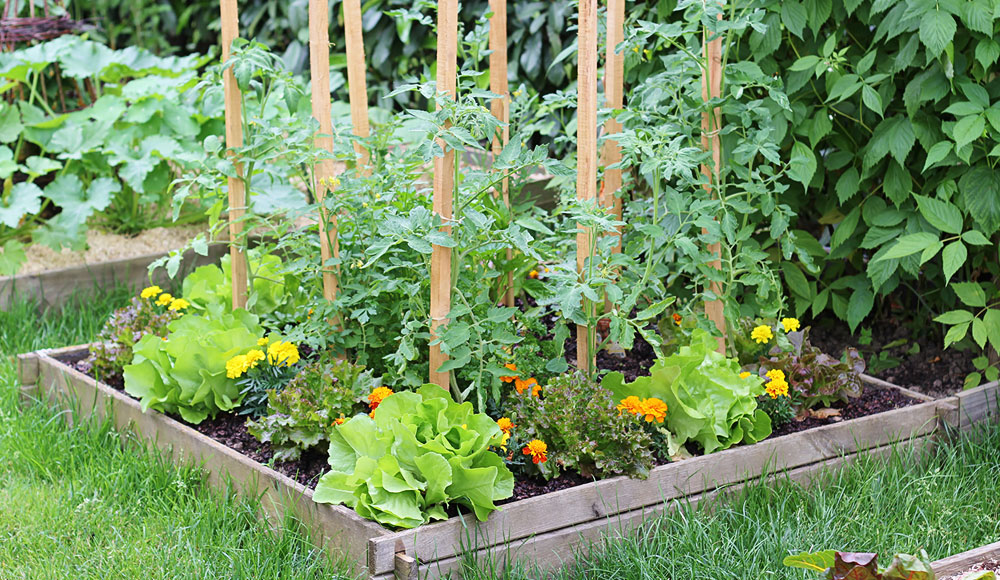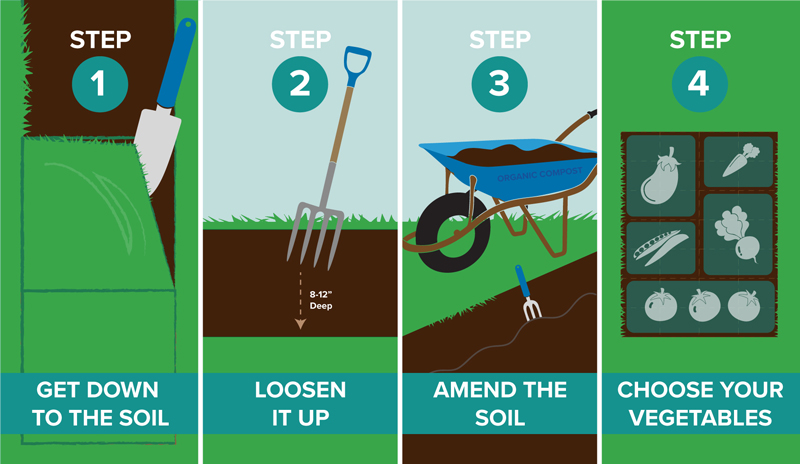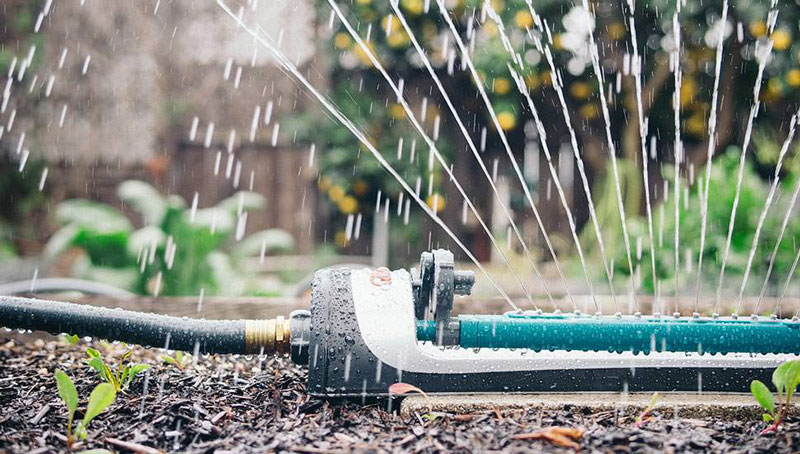


By Linda Ly
Vegetable gardens are no longer just a thing for farmers and big backyards – these days, even an urbanite can grow food on a balcony or roof. In many locales, a front yard is fair game for an edible landscape.
Learning how to start a vegetable garden is probably easier than you might have imagined. In fact, with the right prep and knowhow, you can have a beautiful edible bounty that will be the envy of the neighborhood. If the thought of healthy, homegrown food has you yearning for your own vegetable bed, here’s an ultimate guide for vegetable gardening success.
Vegetable gardens thrive in a space where there’s ample sun for at least eight hours per day and a water source nearby. But if all you can spare is a spot with less light, you can still grow leafy greens, which are happy with partial shade or only six hours of sun per day.
Pick an area close to your house (ideally the kitchen), as you’re more likely to utilize a vegetable garden that you walk past every day. If your garden is relegated to a corner of the yard you can’t see easily and daily, you’re more likely to neglect it. The phrase “out of sight, out of mind” definitely applies to gardens!
If you’re a beginner at growing vegetables, garden size matters! It can be easy to get caught up in the excitement of starting a vegetable garden and go big. But this often leads to an abandoned garden in August. Even seasoned gardeners can misjudge how much garden they can care for throughout an entire garden season. When it comes to garden size, start small and grow as you have time and confidence.
Don’t be afraid of starting a vegetable garden in an unusual location. Many garden vegetables can be grown in containers or raised beds. You can even tuck tomatoes in with your marigolds or grow cucumbers on your patio in interesting containers.

Before you garden, you must reach the soil. If you’re planting a new garden on a grassy area, simply use a spade to cut the grass in your garden area into small squares. Use the end of the spade to lift the squares up and discard. Remove the grass from your entire garden area.
Grab a garden fork and get to digging. You’ll want to loosen the soil to a depth of 8 to 12 inches. You can save your back and let a power tiller do most of the work for you. This is the perfect time to remove rocks and other debris from your vegetable garden.
Few people are fortunate enough to have the loamy soil – 40 percent sand, 40 percent silt and 20 percent clay – most vegetables grow best in. Native soil is often hard, compacted clay or loose, fast-draining sand. If you find yourself with less than ideal soil, it will need a little love before you can plant in it.
Use a garden fork or tiller to work several inches of organic compost into your garden soil. Incorporating organic matter into the soil helps improve drainage and hold nutrients. Amending your garden soil at the beginning of each growing season will help improve your soil over time and replenish its needs.
It’s easy to decide what vegetable garden plants you want to grow. Just ask yourself: What do I like to eat? While some garden vegetables are harder to grow than others, there’s no better way to learn than by just doing. Start with a small list of your favorites. But be careful – it’s easy to plant too much and become overwhelmed. Many new gardeners have a hard time envisioning just how big that little seedling will get.
When choosing what to plant, consider the vegetable garden size you have planned. Larger plants (like tomatoes and squash) require at least two to three feet of space per plant. Small vegetables (like carrots and greens) can be planted very closely together. Vining plants (like peas and cucumbers) need a trellis to climb on, while melons and pumpkins like to sprawl out all over your garden. The number of plants you will be able to grow depends on your garden size. Pay close attention to the planting and spacing guidelines for each plant.
Visit your local garden store and choose a few packets of seeds and some flats of young plants. The easiest plants to grow from seed are:
You can buy six packs or entire flats of young garden vegetable plants. These plants are often harder to start from seed, so it makes sense to just buy them already started. Young plants to purchase can include:
Follow the planting directions on the seed packet, plant tag or container. The planting directions will give you the sunlight needs, moisture requirements, when to plant, spacing between plants and other helpful information. It can be so tempting to jump right in and start planting. But if you can resist temptation and spend a little time preparing, your garden will reward you with a bountiful harvest.
Underwatering and overwatering are often the causes of stunted or distressed plants when vegetable gardening. If you’re starting plants from seed or transplanting starter plants, keep the soil evenly moist until roots are established.
Gilmour’s rectangular sprinklers are ideal for covering a wide area of seeds in the beginning of your vegetable gardening journey. Because of the unique spray pattern, you can be sure that your plants are receiving the amount of irrigation they need while conserving water at the same time.

As your garden vegetables continue to grow and plants become more established, you can stretch out watering sessions to less frequent, but longer. This encourages roots to reach deeper into the soil. A soaker hose makes this easy by delivering water right where it’s needed–at the base of your established plants. No need to drag a traditional hose around your garden beds! Just lay the soaker hose beside your plants, cover with mulch and leave it in place for trouble-free, consistent watering.
Once you have mature plants, you should diligently water less frequently, but more thoroughly. An inch per week through rainfall or irrigation is the usual advice, but how do you know when enough is enough? Simple – just play in the soil. When the first 4 inches of soil feel dry, it’s time to water.
Nature designed plants to produce as many seeds as possible. If you leave a pepper on the stem too long, allowing the seeds inside to mature, the plant will think its job is done and gradually reduce (or even stop) producing more peppers. If you leave a head of kale untouched for half the season, prompting the plant to send up a flower stalk, its leaves will eventually turn too tough and bitter to be palatable.
Make it a habit to check on your garden at least twice per week, and be sure to harvest any vegetables that are ripe or ready. Doing so will encourage plants to continue producing until the end of the growing season.
Now that you know how to grow a vegetable garden, your plants will produce all season long. If you can’t keep up with the bounty, consider sharing with a friend or neighbor!
From the moment you pick it up, you’ll notice these nozzles are different. Designed with mobility in mind, they feature Gilmour’s innovative Swivel Connect. The swivel allows the nozzles to pivot without
Learn MoreWinter Gardening Tips to Tackle in the Off Season
As winter marches on, avid gardeners become more and more eager to get growing. While you may not be able to dig your spade into the soil just yet, there is plenty
Learn MoreDesign a Beautiful Drought Resistant Yard
Hot weather and drought-like conditions don’t mean a beautiful yard and garden is out of reach. Learn everything you need to know about drought tolerant landscaping, including the best type of plants,
Get the Dirt